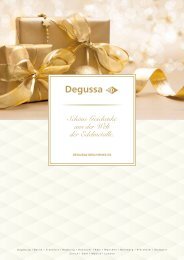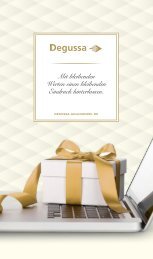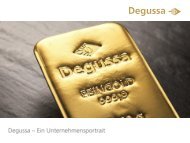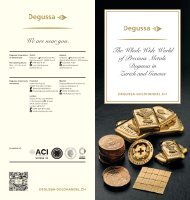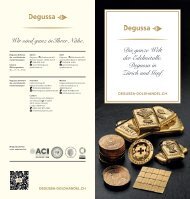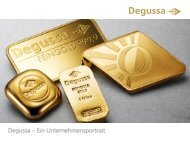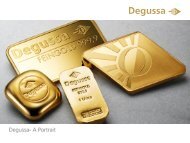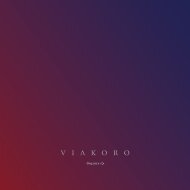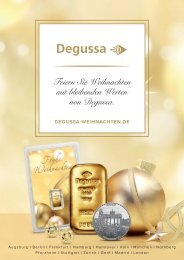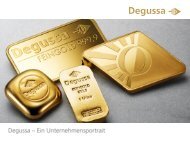Degussa Rothschild Collection
Erfolgreiche ePaper selbst erstellen
Machen Sie aus Ihren PDF Publikationen ein blätterbares Flipbook mit unserer einzigartigen Google optimierten e-Paper Software.
ROTHSCHILD<br />
COLLECTION<br />
THE GLITTER OF A GREAT COLLECTION<br />
EXHIBITION<br />
9 JUNE TO 4 AUGUST 2016<br />
DEGUSSA GENEVA
GOLD MAKES HISTORY<br />
Gold is as ancient as the Book of Genesis which mentioned<br />
the land of Havilah which was abundant with the precious<br />
metal. Similarly, in ancient India the Vedas texts stated that<br />
the incarnation of the Creator himself, Brahma, was born<br />
out of a golden egg. It was, almost certainly, the first metal<br />
known to human beings, who were most likely attracted by<br />
it glistening among the gravel in old river beds.<br />
5’000 years ago, Egyptian hieroglyphics made frequent<br />
reference to it. It was first worked into sacred ornaments<br />
and jewellery being associated with the almighty Sun, and<br />
thus was used for the crowns of its kings. Nothing shone<br />
brighter. However, the turning point was when it became<br />
legal tender as early as 6th century B. C. during the reign<br />
of Croesus, King of Lydia.<br />
Control of the gold mines became a matter of great importance<br />
for early leaders bringing with it both wealth and<br />
power. Since then it has captured the imagination of adventurers<br />
with extraordinary legends about treasures as<br />
famous as the Golden Fleece, King Solomons Mines or<br />
even El Dorado. Alchemists throughout history have sought<br />
to emulate King Midas in transmuting base metals into gold<br />
– without success – while achieving breakthroughs in<br />
chemistry, such as liquid distillation and melting techniques.<br />
Within financial markets, the gold standard became the<br />
norm in the 19th century to limit the amount of<br />
money banks could issue and thus to prevent inflation. In<br />
1910, Nathan Mayer <strong>Rothschild</strong> and other bullion traders<br />
established the London Gold Fixing Market, which set the<br />
benchmark price for gold which endures to this day.<br />
Bretton Woods established the link between gold the<br />
dollar until 1971. Nowadays, gold still provides protection<br />
against inflation while remaining as alluring today as it did<br />
in the times of the Egyptians, Sumerians and Greeks;<br />
its chemical properties include it being ductile, conductive,<br />
hard to forge and even has significant antioxidant<br />
properties that protect it against the passage of time. In<br />
short, it endures.<br />
3
THE GLITTER OF A GREAT COLLECTION<br />
Their surname is a by-word for wealth. The <strong>Rothschild</strong><br />
banking dynasty were of German ancestry and were<br />
behind many of the most important financial events of the<br />
19th century: the construction of the rail transport<br />
network in France, the digging of the Suez Canal, the<br />
operation of the Spanish mines in Río Tinto to name a few.<br />
They even funded the independence of Brazil and the<br />
founding of Rhodesia (modern-day Zimbabwe). Their<br />
focus stretched all the way to Australia, thanks to its large<br />
mineral resources.<br />
Following the extensive family collector tradition, the<br />
Australian branch of the NM <strong>Rothschild</strong> & Sons bank<br />
started acquiring bars of great historical and cultural<br />
significance back in 1993. It managed to amass more than<br />
one thousand items, which were recently obtained by<br />
<strong>Degussa</strong>.<br />
The „<strong>Rothschild</strong> <strong>Collection</strong>“ includes bars from 145 leading<br />
gold manufacturers from 35 different countries. It has a<br />
total weight of 230 kg of pure gold and at current market<br />
prices has a value of around CHF 10 million. The <strong>Rothschild</strong><br />
collection is part of the <strong>Degussa</strong> collection that includes<br />
more than 1’200 unique pieces. The oldest item is dated<br />
from 4’000 B. C.<br />
In addition to the <strong>Collection</strong>, <strong>Degussa</strong> has also acquired<br />
other important artifacts including a variety of bars and<br />
gold pieces from the Bronze Age, the Roman Empire and<br />
the Late Middle Ages. There are also fascinating treasures<br />
to be seen which were recovered from shipwrecks such as<br />
Spanish galleon Nuestra Señora de Atocha which was<br />
sunk by a hurricane off the coast of Florida in 1622.<br />
What makes it special is both its diversity while providing a<br />
comprehensive example of the art of manufacturing gold<br />
bars from around the world. <strong>Degussa</strong> is pleased to be able<br />
to exhibit these items and share their profound interest in<br />
precious metals. The story of gold is a narrative that goes<br />
back to the dawn of civilization.<br />
5
DOUGHNUT BARS<br />
Doughnut bars were manufactured in Thailand since the<br />
early 1970s, although today they are also manufactured in<br />
Hong Kong. The doughnut is a traditional Chinese shape<br />
for coinage. The hole enables many bars to be securely<br />
stacked together on wooden rods or bound together with<br />
string. Popular weights are the 1 tael (Hong Kong) and<br />
2 baht (Thailand).<br />
The <strong>Rothschild</strong> <strong>Collection</strong> has four doughnut bars from<br />
three different manufacturers.<br />
Circular 1 Tael bar<br />
Sung Hung Kai<br />
Hong Kong
TWIN-COIN BARS<br />
The bars, known as Twin Coin bars or twin coins, started<br />
to be manufactured in Thailand by Yoo Long Kim Kee who<br />
was the first known refiner to manufacture cast gold bars<br />
to a precise weight by injecting gold under pressure into<br />
an enclosed mould.<br />
YIN-YANG BARS<br />
Yin-Yang gold bars where produced by the Japanese<br />
manufacturer Ishifuku from 1993 until 2001.<br />
The pair of innovative kidney-shaped bars depicts the Yen<br />
religious symbol representing the harmony of opposites.<br />
2 baht bar<br />
Yoo Long Kim Kee<br />
Thailand<br />
300 g each bar<br />
Ishifuku<br />
Japan<br />
7
BAHT BARS<br />
The baht is a Thai unit of weight. One baht is equivalent<br />
to 15.244 g or 0.4901 oz. Cast baht bars are manufactured<br />
in Thailand in many different shapes. These traditional<br />
shapes resemble those in Hong Kong due to many Thai<br />
bar manufacturers having a Chinese ancestry. The official<br />
stamps on baht bars are among the most decorative in<br />
the world. Evocative designs include elephants, Chinese<br />
dragons, Thai headdresses and the phoenix.<br />
Honeycomb bars are manufactured by blowing<br />
air onto the surface of the molten gold as it<br />
cools. The cracked surface enables the buyer<br />
to confirm that the bar is made entirely from<br />
gold.<br />
Honeycomb bars were widely traded in Thailand<br />
until the 1970s.<br />
In Thailand, bars with manufacturer’s marks<br />
in bas-relief are still issued.<br />
The marks, carved into the base of the bar<br />
mould, are formed when molten gold is poured<br />
into the mould. This traditional method<br />
of marking cast bars eliminates the need for<br />
conventional marking tools (dies, punches and<br />
hammers).<br />
28.87 baht honeycomb bar<br />
Loo Chang Huat<br />
Thailand<br />
20 baht bas-relief bar<br />
Tang Toh Kang<br />
Thailand<br />
8
TOLA BARS<br />
The tola is an Indian unit of weight which is in widespread<br />
use throughout Southeast Asia. The most popular cast<br />
tola bar weighs 10 tolas, equivalent to 3.75 oz. They have<br />
smooth, rounded edges and no serial numbers.<br />
For more than 50 years, the Indian gold market relied<br />
heavily on the import of these small bars (alongside the<br />
recycling of old gold) for the fabrication of jewellery. Most<br />
were manufactured in Switzerland, UK, South Africa and<br />
Australia, and until the late 1990s, most were imported into<br />
Dubai and Singapore prior to their re-export to India.<br />
In 2003, however, the era of the 10 tola bar came to an<br />
end, when the Indian government applied an import tax on<br />
tola bars that was higher than on gram-denominated bars.<br />
The 1 kg bar, which is often cut into small tradable pieces,<br />
is now the main bar imported into India.<br />
10 tola bar<br />
<strong>Degussa</strong><br />
Singapore<br />
10 tola bar<br />
Bangkok Assay<br />
Thailand<br />
9
CUSTOM BARS<br />
Accredited refiners such as <strong>Degussa</strong> often produce bars<br />
with the names of the banks trading them. Indian financial<br />
firms are currently the main clients of this type of product.<br />
MINTED BARS<br />
Minted bars are normally cut from a cast bar that has been<br />
rolled to a uniform thickness. The cutting is usually done with<br />
a die to create blanks that have the required dimensions and<br />
weight. All the surfaces are smooth and even. Markings are<br />
normally applied by a minting press. Although most minted<br />
bars are rectangular, they are also manufactured round,<br />
square, oval, etc ; sometimes even with a hole so they can<br />
be worn.<br />
50 g bar<br />
<strong>Rothschild</strong> bank<br />
United Kingdom<br />
1 g bar<br />
<strong>Degussa</strong><br />
Germany<br />
11
TAEL BARS<br />
A tael is a Chinese unit of weight. In Hong Kong, one tael<br />
is equivalent to 1.20337 oz or 37.429 g and its gold purity<br />
is normaly 99 %. Gold bars, denominated in taels, were<br />
traditionally traded in Chinese speaking countries and<br />
where there were Chinese communities, especially within<br />
Southeast Asia.<br />
In recent times, the bars have been traded mainly within<br />
Hong Kong and Taiwan. Cast tael bars have been<br />
manufactured in Hong Kong in three traditional shapes:<br />
‘biscuit’, ‘doughnut’ (or round) and ‘boat’.<br />
Biscuit bars were manufactured mainly<br />
in Hong Kong by refiners or issuers<br />
accredited to The Chinese Gold & Silver<br />
Exchange Society (founded in 1910).<br />
They are still traded in significant<br />
quantities.<br />
5 tael biscuit bar<br />
King Fook<br />
Hong Kong<br />
Gold bars in boat formats<br />
have been manufactured<br />
in Thailand, Hong Kong<br />
and China. The traditional<br />
“boat” shape has been<br />
used for silver and other<br />
Chinese coinage since as<br />
far back as the Han dynasty<br />
(206 B. C.).<br />
5 tael boat bar<br />
King Fook<br />
Hong Kong<br />
13
KILO BARS<br />
The cast kilo bar (1000 g) is the world’s most widely<br />
manufactured and traded small gold bar.<br />
They are popular among fabricators and large investors<br />
because they normally trade at a low premium above<br />
the prevailing value of their fine gold content.<br />
1 kilo bar<br />
<strong>Degussa</strong><br />
Brazil<br />
While almost all kilo bars now have a fat ‘international’<br />
shape, ‘traditional’ kilo bars in the shape of a brick, were<br />
still being manufactured by some refiners in the 1990s<br />
and 2000s.<br />
Today <strong>Degussa</strong> bars are certified by the London Bullion<br />
Association LBMA and can by held in the Bank depot<br />
account as of the Swiss Valor number.<br />
15
MODEL AND DECORATIVE BARS<br />
Designs of model bars range from animals, trees and<br />
towers to national symbols and even celebrities.<br />
In 1991 LG Metals South Korea issued a traditional range of<br />
gold “model bars” in the form of pigs (a symbol of wealth),<br />
toads (good fortune) and turtles (longevity). Denominated<br />
in dons, a Korean unit of weight, 1 don = 3.75 g. They are<br />
normally traded at a relatively low premium above the<br />
value of their gold content. They are popular as gifts of<br />
“money” at weddings and anniversaries.<br />
<strong>Degussa</strong> (Brazil) manufactured<br />
a range of innovative gold bars<br />
in an unconventional “bone”<br />
shape in 1982.<br />
11.25 g gold turtle<br />
LG Metals<br />
South Korea<br />
18.75 g gold toad<br />
LG Metals<br />
South Korea<br />
100 g gold bone<br />
<strong>Degussa</strong><br />
Brazil<br />
37.50 g gold pig<br />
LG Metals<br />
South Korea<br />
17
LEAF BARS<br />
From the 1930s until the 1970s, unusual “gold leaf” bars<br />
were widely manufactured in Vietnam. The standard bar<br />
weight is approximately 15 g, although they were also<br />
sold in lengths of 2 1/2 bars that weigh approximately<br />
37.5 g. Their thinness makes them extremely portable,<br />
easily placed inside shoes, sewn into the lining of clothes<br />
or rolled into narrow tubes. Thousands of these bars,<br />
smuggled by Vietnamese refugees were sold to gold<br />
dealers around the world in the 1970s.<br />
FINE ART & KOBAN BARS<br />
The Singapore Mint issued two series of innovative minted<br />
gold bars in 1994. The Balinese Girl (75 g) is one of<br />
4 decorative “Fine Art” bars. The bars were issued at a<br />
fixed price.<br />
Tokuriki Honten (Japan) has manufactured attractive<br />
“Koban”gold bars since the early 1960s, ranging from<br />
5 g to 50 g. The bars commemorate the oval shape of<br />
traditional Japanese coinage issued between the 16th<br />
and 19th centuries.<br />
15 g Leaf bar<br />
Kim Thanh<br />
Vietnam<br />
7,4 g Leaf bar<br />
Kim Thanh<br />
Vietnam<br />
75 g bar „Balinese Girl“<br />
Singapore Mint<br />
Singapore<br />
50 g Koban bar<br />
Tokuriki<br />
Japan<br />
18
COMMEMORATIVE & PENDANT BARS<br />
<strong>Degussa</strong> produced a number of these bars during the<br />
1980s and 1990s. Depicting sports events, cars, ships,<br />
cities and special events like the Olympic Games were<br />
popular. Today, these gold bars are collectors’ items which<br />
often achieve a high premium over the spot price.<br />
Tonnes of pendant bars are sold each year, mainly in the<br />
Middle East. In 1978, <strong>Degussa</strong> was the first accredited<br />
refiner to incorporate a hole in the bar to facilitate its use<br />
as a pendant. Today, <strong>Degussa</strong> is expanding its wide range<br />
of pendant bars.<br />
Since 2012 <strong>Degussa</strong> is been producing them once again<br />
with similar depictions primarily on 1 oz Silver bars with<br />
images of leading cities.<br />
1 oz bar dolphin<br />
Banespa<br />
Brazil<br />
5 g octogonal bar<br />
<strong>Degussa</strong><br />
Germany<br />
10 g heart-shaped bar<br />
Ary<br />
UAE<br />
1/2 oz bar cycling<br />
<strong>Degussa</strong><br />
Germany<br />
19
FINE GOLD CARDS<br />
Fine gold cards were introduced by Mitsubishi (Japan) in<br />
the late 1980s who developed multi-coloured printing<br />
designs which could be applied to the smooth gold surfaces.<br />
Although fine gold cards up to 1000 g have been made,<br />
the 1 g card remains the most popular. While the main<br />
market is Japan, tailor-made cards have also been<br />
produced for other countries.<br />
1 g card with the three wise monkeys<br />
Tanaka<br />
Japan<br />
1 g calendar card<br />
Tanaka<br />
Japan<br />
1 g christmas card<br />
Mitsubishi<br />
Japan<br />
21
DEGUSSA AT A GLANCE<br />
In 2010 we founded our company and<br />
named it „<strong>Degussa</strong>“. A name, with historical<br />
roots in gold going back to 1843.<br />
Our business is deeply committed<br />
and embedded in the precious metals<br />
world and we remain close to the traditions<br />
of the earlier times. As such,<br />
<strong>Degussa</strong> has a wide range of precious<br />
metals in the form of bars and coins.<br />
You will find our products at our<br />
branch in Zurich and Geneva.<br />
Abroad we also have branches throughout<br />
Germany, in London, Singapore and<br />
Madrid.<br />
We offer a comprehensive range of<br />
precious metal bars and coins to meet<br />
your needs. <strong>Degussa</strong> bars feature the<br />
logo with the iconic <strong>Degussa</strong> logo<br />
– the sun and moon – framed by a<br />
diamond. These two celestial bodies<br />
are ancient alchemical symbols for<br />
gold and silver.<br />
We also offer a special service to<br />
you at our Zurich and Geneva office,<br />
where we have available safe deposit<br />
boxes for you to store your precious<br />
metals after a purchase. This gives<br />
you the opportunity to store your assets<br />
safely and discretely outside the<br />
banking sector. Of course, you are<br />
free to keep jewellery, documents<br />
and other valuables in your safe<br />
deposit box too.<br />
23
ZURICH<br />
Bleicherweg 41 · 8002 Zurich<br />
Phone: 044 403 41 10 · zuerich@degussa-goldhandel.ch<br />
GENEVA<br />
Quai du Mont-Blanc 5 · 1201 Geneva<br />
Phone: 022 90814 00 · geneve@degussa-goldhandel.ch<br />
DEGUSSA-GOLDHANDEL.CH<br />
FRANKFURT · Kettenhofweg 29 · 60325 Frankfurt<br />
Phone: 0049-69-860 068 100 · frankfurt@degussa-goldhandel.de<br />
MADRID · <strong>Degussa</strong> Metales Preciosos S. L.<br />
Calle de Velázquez 2 · 28001 Madrid<br />
Phone: 0034-911-982 900 · info@degussa-mp.es<br />
SINGAPORE · <strong>Degussa</strong> Precious Metals Asia Pte. Ltd.<br />
22 Orchard Road 01-01 · Singapore 238885<br />
Phone: 0065-6804 5080 · info@degussa-pm.sg<br />
LONDON · Sharps Pixley Ltd. (Member of the <strong>Degussa</strong><br />
54 St James’s Street · London SW1A 1JT<br />
Phone: 0044-207 871 0532 · info@sharpspixley.com<br />
Group)






